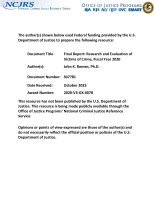Multiple Victimization
The cascade of victimization: Multiple victimizations, PTSD symptoms, and educational consequences among college students at Hispanic-serving institutions
Moving Forward: Recommendations for Advancing Late Life Polyvictimization Practice, Policy, and Research
Verified Human Trafficking Allegations Among Single and Dual System-Involved Children: Predicting Initial and Repeat Victimization
The Prevalence and Nature of Victimization among First Semester Students at Urban, Hispanic-Serving Institutions (HSIs)
Using Scammers’ Data to Estimate the Impact and Importance of Preventing Repeat Mail Fraud Victimization
Gratitude for Bystander Action Varies by Peer Intervention and Social Norms
Fraud Victimization Across the Lifespan: Evidence on Repeat Victimization Using Perpetrator Data
Familial Pathways to Polyvictimization for Sexual and Gender Minority Adolescents: Microaffirming, Microaggressing, Violent, and Adverse Families
Structural Constraints, Risky Lifestyles, and Repeat Victimization
Study of the Impact of Screening for Poly-Victimization in Juvenile Justice: The Rocky Road to a Successful Investigation in the Real World
The relationships among prior gang involvement, current gang involvement, and victimization among youth in residential placement
Final Report: New Estimates of the Costs of Criminal Victimization
Violence and aggression toward teachers among 50 largest school districts: A longitudinal examination of risk factors, negative consequences, and school responses
Defining and Studying Elder Abuse Polyvictimization
NIJ Social Science Analyst Yunsoo Park shares her knowledge about elder abuse, a widespread issue in the U.S. and around the world, particularly polyvictimization — the experience of a range of different types of abuse and maltreatment. As much as 11% of community-residing older adults experienced some form of abuse or mistreatment in the past year. Yunsoo discusses risk factors, difficulties in defining and studying elder abuse polyvictimization, and strategies for intervention and prevention. Stacy Lee Reynolds, a Communications Assistant with NIJ, hosts.




